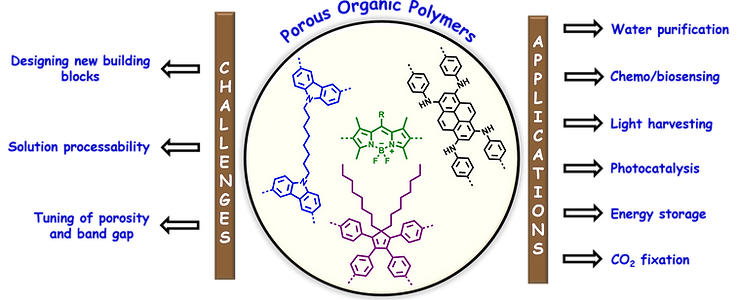
RESEARCH
POROUS ORGANIC POLYMERS
Conjugated Porous Organic Polymers
__________________________________________________________
Porous organic polymers (POPs) have attracted significant attention in the last few years. High specific surface areas and tractable pores, superior hydrothermal and chemical stability, low density, etc., make POPs a suitable candidate for multifarious applications ranging from gas storage, separation, heterogeneous catalysis, to water purification. Amidst all the advantages, the judicious inclusion of π-electron conjugation in the network makes the conjugated porous organic polymer (CPOPs) unique from all other porous materials. Hence, CPOPs became popular for their multimodal applications like sensing, light-harvesting, photocatalysis and energy storage. In this present scenario of the field, our group took up the problem to meet challenges like designing the task-specific building blocks, tuning the bandgap and porosity and most importantly, developing POPs with solution processability. Along with the design strategy, we have also demonstrated the efficacy of POPs in diverse applications ranging from chemosensing, light-harvesting, energy storage, photocatalysis, metal-free carbon dioxide fixation to intracellular reactive oxygen species generation.

Cavitand/Cage based Porous Organic Polymers
__________________________________________________________
Supramolecular hosts, e.g., macrocycles, cavitands, cages possess large cavities to accommodate small molecules and ions. The confined space of these molecular hosts with excellent guest recognition properties leads to diverse applications ranging from catalysis, molecular separation, sensing to the development of artificial molecular machines. In our lab, we focus on fabricating materials that can exhibit the characteristics of both the cavitand/cage as well a porous organic polymer (POPs) through knitting cavitands/organic cages as a monomeric unit in the polymeric network.

__________________________________________________________
Covalent Oragnic Framework
Covalent organic frameworks (COFs) are an emerging class of crystalline porous organic materials. Due to the crystallinity, the materials have well-defined pores and high surface areas. In our lab, we focus on designing 2D COFs particularly for catalysis, energy storage and conversion.

SMALL ORGANIC LUMINOGENS
Fluorescent organic materials are playing an important role in scientific research owing to their potential applications in the fields of sensors, switches, optoelectronic materials and imaging. Environment-sensitive fluorescent molecules with high photostability and quantum yield are in increasing demand. Fluorescence-based sensing and imaging probes have received significant attention owing to their excellent sensitivity and spatiotemporal resolution. Detection in aggregated or solid states, as well as in solution, is particularly important for real-time applications.
__________________________________________________________
Organic long-lived Emissive Materials
Synthesis of novel organic materials with long-lived luminescence have attracted considerable interest for their potential applications towards solid-state devices, sensors, and imaging. In this regard, organic thermally activated delayed fluorescence (TADF) and room temperature phosphorescence (RTP) materials are gaining interest due to their intriguing
ability to harvest both the singlet and triplet excitons. Donor-acceptor architecture with a stable triplet state, strong intersystem crossing, spin-orbit coupling interactions are beneficial to induce triplet harvesting in TADF and RTP materials. Our group focuses on delineating the underlying photophysical pathways of the long-lived luminescence using time-resolved spectroscopy and applies such materials for security encryption and bioimaging, including fluorescence lifetime imaging (FLIM).

Fluorescent Supramolecular Self-Assembly
__________________________________________________________
Supramolecular self-association of small π-conjugated organic molecules leads to well-defined nanoarchitectures like vesicles, micelles, low molecular weight gels, and other noncovalent aggregates. In this context, molecular aggregates with size and morphology-dependent tunable emission capture significant attention because of diverse applications in sensing, switching, light-harvesting, bioimaging, etc. However, the correlation between the shape and size (solid-state characterization) and the emission behavior (dispersion-state analysis) of the aggregates is often rudimentary and can be beneficial through further analysis. Thus, our group focuses on elucidating the formation of different nanoarchitectures, exploring the different dynamic processes of molecular self-assembly, and intracellular activities using a combined microscopic (FESEM, TEM, AFM) and spectroscopic approach (steady-state, lifetime, TRES, FCS, FLIM analyses).

__________________________________________________________
Electrochromic and Electrofluorochromic Materials
Electrochromism and electrofluorochromism refer to the reversible change of absorption and fluorescence in response to external electric potential. Currently we are working on the redox-active small organic molecules and polymers for electrochromic-electrofluorochromic applications.

NANOMATERIALS
Nanomaterials are the building blocks of practical nanotechnology and can be physically and chemically manipulated for specific applications. The properties of matter change quite dramatically when their size is made lesser than 100 nm. The shape and size of the nanomaterials have a great impact on their properties. Hence, the physical and chemical properties can be tuned for task-specific applications. In our laboratory, we fabricate (i) organic, (ii) inorganic (quantum dots), and (iii) organic-inorganic hybrid nanomaterials (organic dye decorated upconversion nanomaterials). The prepared nanomaterials have been mostly used for intracellular sensing, bioimaging, solid-state lighting and photocatalysis.

Background courtesy: Mr. Arkaprabha Giri


